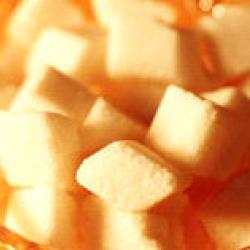Source Institutions
Source Institutions
Add to list Go to activity
Activity link broken? See if it's at the internet archive

This lesson focuses on surface area and how the shape of sugar crystals may differ as they are grown from sugars of different coarseness. Learners explore surface area, nanostructures, and work in teams and participate in hands-on activities. Safety: need an adult to handle the very hot water.
- 5 to 10 minutes
- 1 to 7 days
- $1 - $5 per group of students
- Ages 8 - 14
- Activity, Experiment/Lab Activity, Lesson/Lesson Plan
- English
Quick Guide
Materials List (per group of students)
- Resource Sheets
- Worksheets
- Microscope or camera scope
- Two clean thermal glass cups or measuring cups of at least 4 cup capacity
- Access to warm water
- 1 teaspoon granulated sugar
- 1 teaspoon powdered sugar
- 2 lengths of thin cotton string that are 1.5 times as long as the cup is tall
- 2 pencils or sticks
- Weight to hang on string (washer or screw)
- 3 cups of granulated sugar
- 3 cups of powdered or confectioners' sugar
- 2 cups very hot water (poured by adult)
Subjects
-
Engineering and Technology
-
Engineering
- Bioengineering/Biomedical Engineering
- Metallurgy and Materials Engineering
- Nanotechnology
- Transportation Engineering
-
Technology
- Medical Technology
- Transportation
-
Engineering
-
Mathematics
-
Algebra
- Equations and Inequalities
-
Geometry
- Solid Geometry
-
Measurement
- Units of Measurement
- Size and Scale
-
Algebra
-
Physical Sciences
-
Heat and Thermodynamics
- Heat and Temperature
-
Chemistry
- Chemical Bonding
- Chemical Reactions
- Solutions
-
States of Matter
- Solids
- Liquids
-
Structure and Properties of Matter
- Atomic Structure
-
Heat and Thermodynamics
-
The Nature of Science
-
The Scientific Process
- Conducting Investigations
- Gathering Data
- Formulating Explanations
- Communicating Results
-
The Scientific Process
-
The Nature of Technology
-
Technology and Society
- Impacts of Technology
-
The Design Process
- Invention and Innovation
-
Technology and Society
Informal Categories
- Food and Cooking
Audience
To use this activity, learners need to:
- see
- read
- touch
Learning styles supported:
- Involves teamwork and communication skills
- Involves hands-on or lab activities
Other
Components that are part of this resource:
Includes alignment to state and/or national standards:
This resource is part of:
Access Rights:
- Free access
By:
Rights:
- All rights reserved, IEEE,
